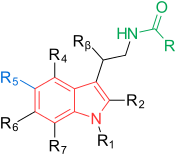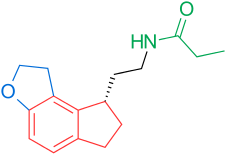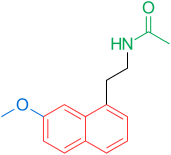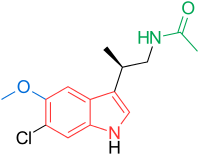
Melatonin is a natural compound, specifically an indoleamine, produced by and found in different organisms including bacteria and eukaryotes. It was discovered by Aaron B. Lerner and colleagues in 1958 as a substance of the pineal gland from cows that could induce skin lightening in common frogs. It was subsequently discovered as a hormone released in the brain at night which controls the sleep–wake cycle in vertebrates.
Non-24-hour sleep–wake disorder is one of several chronic circadian rhythm sleep disorders (CRSDs). It is defined as a "chronic steady pattern comprising [...] daily delays in sleep onset and wake times in an individual living in a society". Symptoms result when the non-entrained (free-running) endogenous circadian rhythm drifts out of alignment with the light–dark cycle in nature. Although this sleep disorder is more common in blind people, affecting up to 70% of the totally blind, it can also affect sighted people. Non-24 may also be comorbid with bipolar disorder, depression, and traumatic brain injury. The American Academy of Sleep Medicine (AASM) has provided CRSD guidelines since 2007 with the latest update released in 2015.

Agomelatine, sold under the brand names Valdoxan and Thymanax, among others, is an atypical antidepressant most commonly used to treat major depressive disorder and generalized anxiety disorder. One review found that it is as effective as other antidepressants with similar discontinuation rates overall but fewer discontinuations due to side effects. Another review also found it was similarly effective to many other antidepressants.

Ramelteon, sold under the brand name Rozerem among others, is a melatonin agonist medication which is used in the treatment of insomnia. It is indicated specifically for the treatment of insomnia characterized by difficulties with sleep onset. It reduces the time taken to fall asleep, but the degree of clinical benefit is small. The medication is approved for long-term use. Ramelteon is taken by mouth.
Melatonin receptors are G protein-coupled receptors (GPCR) which bind melatonin. Three types of melatonin receptors have been cloned. The MT1 (or Mel1A or MTNR1A) and MT2 (or Mel1B or MTNR1B) receptor subtypes are present in humans and other mammals, while an additional melatonin receptor subtype MT3 (or Mel1C or MTNR1C) has been identified in amphibia and birds. The receptors are crucial in the signal cascade of melatonin. In the field of chronobiology, melatonin has been found to be a key player in the synchrony of biological clocks. Melatonin secretion by the pineal gland has circadian rhythmicity regulated by the suprachiasmatic nucleus (SCN) found in the brain. The SCN functions as the timing regulator for melatonin; melatonin then follows a feedback loop to decrease SCN neuronal firing. The receptors MT1 and MT2 control this process. Melatonin receptors are found throughout the body in places such as the brain, the retina of the eye, the cardiovascular system, the liver and gallbladder, the colon, the skin, the kidneys, and many others. In 2019, X-ray crystal and cryo-EM structures of MT1 and MT2 were reported.

N-Acetylserotonin (NAS), also known as normelatonin, is a naturally occurring chemical intermediate in the endogenous production of melatonin from serotonin. It also has biological activity in its own right, including acting as a melatonin receptor agonist, an agonist of the TrkB, and having antioxidant effects.
A nicotinic agonist is a drug that mimics the action of acetylcholine (ACh) at nicotinic acetylcholine receptors (nAChRs). The nAChR is named for its affinity for nicotine.

Melatonin receptor type 1A is a protein that in humans is encoded by the MTNR1A gene.

Melatonin receptor 1B, also known as MTNR1B, is a protein that in humans is encoded by the MTNR1B gene.
Triptans is a word commonly used for a class of anti-migraine drugs that are selective 5-hydroxytryptamine/serotonin1B/1D (5-HT1B/1D) agonists. Migraine is a complex disease which affects about 15% of the population and can be highly disabling. Triptans have advantages over ergotamine and dihydroergotamine, such as selective pharmacology, well established safety record and evidence-based prescribing instructions. Triptans are therefore often preferred treatment in migraine.
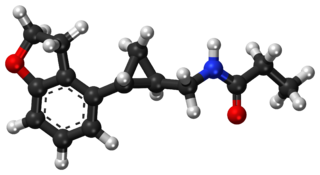
Tasimelteon, sold under the brand name Hetlioz, is a medication approved by the U.S. Food and Drug Administration (FDA) in January 2014, for the treatment of non-24-hour sleep–wake disorder. In June 2014, the European Medicines Agency (EMA) accepted an EU filing application for tasimelteon and in July 2015, the drug was approved in the European Union for the treatment of non-24-hour sleep-wake rhythm disorder in totally blind adults, but not in the case of non-24 in sighted people.

Substituted tryptamines, or serotonin analogues, are organic compounds which may be thought of as being derived from tryptamine itself. The molecular structures of all tryptamines contain an indole ring, joined to an amino (NH2) group via an ethyl (−CH2–CH2−) sidechain. In substituted tryptamines, the indole ring, sidechain, and/or amino group are modified by substituting another group for one of the hydrogen (H) atoms.

TIK-301 (LY-156735) is an agonist for the melatonin receptors MT1 and MT2 that is under development for the treatment of insomnia and other sleep disorders. Its agonist action on MT1 and MT2 receptors in the suprachiasmatic nucleus in the brain enables its action as a chronobiotic. It is in the same class of melatonin receptor agonists as ramelteon and tasimelteon.

Piromelatine (Neu-P11) is a multimodal sleep drug under development by Neurim Pharmaceuticals. It is an agonist at melatonin MT1/MT2 and serotonin 5-HT1A/5-HT1D receptors. Neurim is conducting a phase II randomized, placebo controlled trial of cognitive and sleep effects in Alzheimer's disease.
Margarita L. Dubocovich, Ph.D., FACNP, FASPET is an Argentine neuropharmacologist currently a SUNY Distinguished Professor at University of Buffalo, State University of New York.

Willardiine (correctly spelled with two successive i's) or (S)-1-(2-amino-2-carboxyethyl)pyrimidine-2,4-dione is a chemical compound that occurs naturally in the seeds of Mariosousa willardiana and Acacia sensu lato. The seedlings of these plants contain enzymes capable of complex chemical substitutions that result in the formation of free amino acids (See:#Synthesis). Willardiine is frequently studied for its function in higher level plants. Additionally, many derivates of willardiine are researched for their potential in pharmaceutical development. Willardiine was first discovered in 1959 by R. Gmelin, when he isolated several free, non-protein amino acids from Acacia willardiana (another name for Mariosousa willardiana) when he was studying how these families of plants synthesize uracilyalanines. A related compound, Isowillardiine, was concurrently isolated by a different group, and it was discovered that the two compounds had different structural and functional properties. Subsequent research on willardiine has focused on the functional significance of different substitutions at the nitrogen group and the development of analogs of willardiine with different pharmacokinetic properties. In general, Willardiine is the one of the first compounds studied in which slight changes to molecular structure result in compounds with significantly different pharmacokinetic properties.

2-Iodomelatonin is a melatonin analog used as a radiolabelled ligand for the melatonin receptors, MT1, MT2, and MT3. It acts as a full agonist at both MT1 and MT2 receptors.

Melatonin is a dietary supplement and medication as well as naturally occurring hormone. As a hormone, melatonin is released by the pineal gland and is involved in sleep–wake cycles. As a supplement, it is often used for the attempted short-term treatment of disrupted sleep patterns, such as from jet lag or shift work, and is typically taken orally. Evidence of its benefit for this use, however, is not strong. A 2017 review found that sleep onset occurred six minutes faster with use, but found no change in total time asleep.
Gabriella Gobbi is an Italo-Canadian psychiatrist and neuroscientist whose research explores novel treatments for mental health disorders. Gobbi is a professor at McGill University's Department of Psychiatry and a Canada Research Chair in Therapeutics for Mental Health.

Somnifacient, also known as sedatives or sleeping pills, is a class of medications that induces sleep. It is mainly used for treatment of insomnia. Examples of somnifacients include benzodiazepines, barbiturates and antihistamines.




